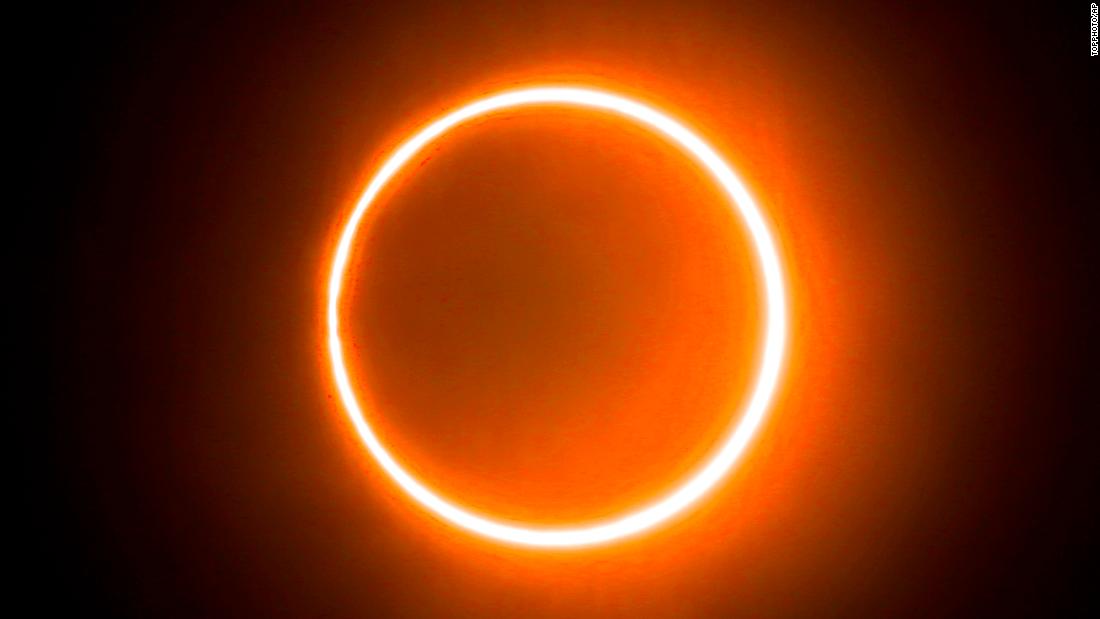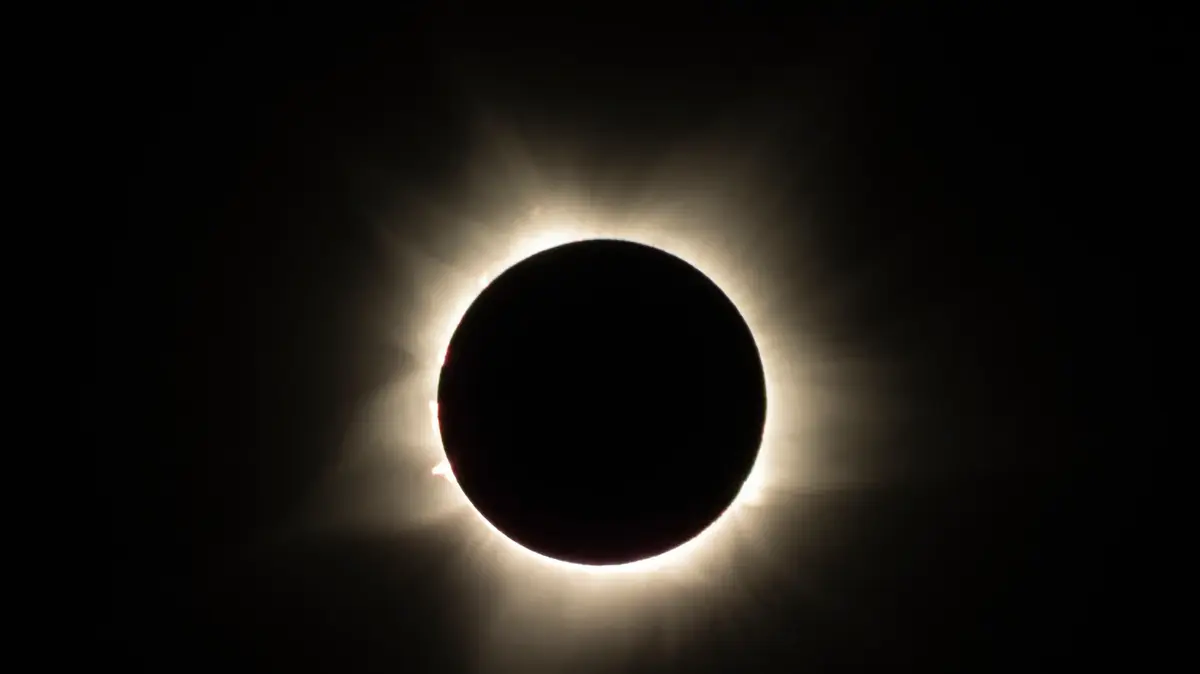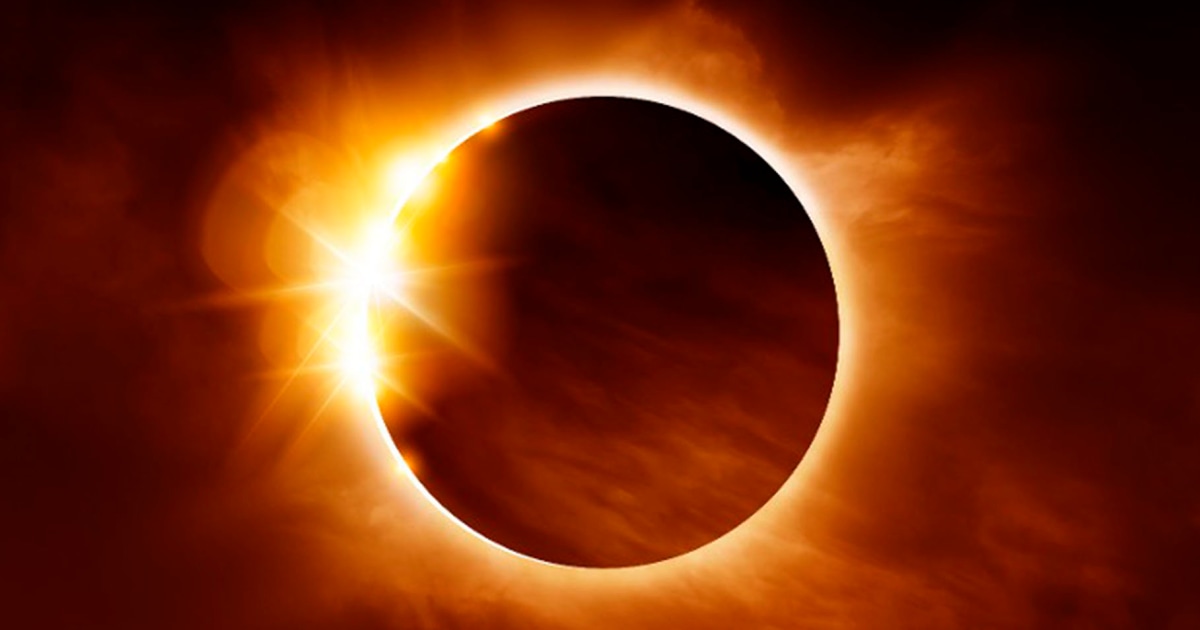This will be the first solar eclipse of 2021 0:52
(CNN) -
The Moon will partially block the Sun this Thursday to create a solar eclipse known as a "ring of fire."
Some people who are in the northern hemisphere will be able to see the first of the two solar eclipses of the year on June 10.
A solar eclipse occurs when the Moon crosses between the Sun and Earth, blocking part of the Sun's rays, according to NASA.
This is an annular eclipse, which means that the Moon is so far from Earth that it appears smaller than the Sun.
When the Moon crosses its way to the burning star, it will look smaller than the Sun, leaving room for a light to shine around the edges.
This is called the "ring of fire," which will be seen by some people in Greenland, northern Russia and Canada, NASA said.
advertising
This June 10 there is an annular solar eclipse 1:09
"Annular" comes from the Latin
annulus
, which means ring-shaped, according to the Farmers' Almanac.
Other countries in the Northern Hemisphere may see a partial eclipse - including the United Kingdom and France - which is when the Moon covers part of the Sun. In this case, a fingernail-shaped shadow will cover different parts of the Sun depending on the location where one is.
The annularity trajectory, which traces where the ring of fire is visible, will begin over the northern United States, then cross the Arctic and end in northeastern Russia, according to the Farmers' Almanac.
When can the solar eclipse be seen
The Moon will begin to cover the Sun at 4:12 am ET (1:42 pm IST) on June 10, according to the Old Farmer's Almanac.
The annular eclipse begins at 5:50 am ET (3:20 pm IST), peaks at 6:42 am ET (4:12 pm IST), and ends at 7:34 am ET (5:04 pm IST)).
The partial eclipse, meanwhile, ends at 9:11 am ET (6:41 pm IST).
To see the specific time according to your geographic location, you can check TimeAndDate.com.
If you can't see the eclipse live, NASA and the Virtual Telescope Project will broadcast.
How to view the eclipse safely
How to take pictures of the lunar eclipse with your cell phone 3:02
As some of the Sun's rays will shine from behind the Moon, it is important to wear proper eye protection to view the solar eclipse, according to the American Astronomical Society (AAS).
When you buy a sunscreen, make sure it meets the international standard ISO 12312-2 to protect your eyes.
"Eclipse glasses" cost a couple of dollars and are the only safe way to view the eclipse, says the AAS.
Here are some additional safety tips to remember, according to the American Astronomical Society:
Always check your sunscreen before using it.
If it's scratched, punctured, torn, or damaged in any other way, throw it away.
Read and follow the instructions printed or on the filter packaging.
Always supervise children when they use sunscreen.
If you normally wear glasses, keep them on.
Put on your eclipse glasses or hold the handheld visor in front of the glasses.
Stand still and cover your eyes with your eclipse glasses or solar viewer before looking up at the bright Sun.
After looking at the Sun, turn around and remove the filter, do not remove it while you are looking at the Sun.
Do not look at the Sun without an eclipse or with a partial clip through a camera, telescope, binoculars, or other optical device without a filter.
Also, do not look at the Sun through a camera, telescope, binoculars, or any other optical device while wearing your eclipse glasses or handheld solar viewer, as concentrated solar rays could damage the filter and enter your eyes, causing serious injury.
Before using a solar filter with a camera, telescope, binoculars, or any other optical device, seek the advice of an expert.
You should keep in mind that the sunscreens must be placed on the front of any telescope, binoculars or camera lenses.
Solar and lunar eclipses
This year, in addition to the two solar eclipses there will be two lunar eclipses.
Three of the four will be visible to some people in North America, according to The Old Farmer's Almanac.
After the solar eclipse on June 10, the next opportunity to see an eclipse will only be on November 19.
On that date, a partial lunar eclipse will be seen in North America and Hawaii between 1 am ET and 7:06 am ET.
The year will end with a total solar eclipse on December 4.
It won't be visible in North America, but those living in the Falkland Islands, the southern tip of Africa, Antarctica, and southeastern Australia will get a glimpse of it.
Here we tell you what other phenomena can be seen in the remainder of the year in the sky.
Full moons
As in a typical year, 2021 has 12 full moons.
(There were 13 full moons last year, two of which were in October.)
You can not miss these 4 appointments with space in June 1:03
Here are all the full moons left this year and their names, according to the Old Farmer's Almanac:
June 24 - Strawberry Moon
July 23 - - deer moon
August 22 - sturgeon moon
September 20 - Harvest Moon
October 20 - Hunter's Moon
November 19 - Beaver Moon
December 18 - cold moon
Be sure to look up the other names for these moons as well, attributed to their respective Native American tribes.
Meteor showers
The Delta Aquarid meteor shower is best viewed from the southern tropics and will peak between July 28-29, when the moon is 74% full.
Interestingly, another meteor shower peaks on the same night: the Alpha Capricorns.
Although this is a much weaker shower, it is known to produce some bright fireballs during its peak.
It will be visible to everyone, regardless of which side of the equator you are on.
The Perseid meteor shower, the most popular of the year, will peak between August 11-12 in the Northern Hemisphere, when the moon is only 13% full.
When can you see the meteor shower?
0:58
Here's the meteor shower schedule for the rest of the year, according to EarthSky's meteor shower forecast.
October 8: Draconids
October 21: Orionids
November 4-5: Southern Taurids
November 11-12: Northern Taurids
November 17: Leonidas
December 13-14: Geminids
December 22: Ursidas
Visible planets
Sky watchers will have multiple opportunities to spot planets in our sky on certain mornings and nights throughout 2021, according to the Old Farmer's Almanac planetary guide.
Most of these can be seen with the naked eye, with the exception of distant Neptune, but binoculars or a telescope will provide the best view.
Mercury will appear as a bright star in the sky during sunrise from June 27 to July 16 and from October 18 to November 1.
It will shine in the night sky from August 31 to September 21 and from November 29 to December 31.
Venus, our closest neighbor in the solar system, will appear in the western sky at dusk in the afternoons of May 24 to December 31.
It is the second brightest object in our sky, after the Moon.
7 things NASA is doing on Mars 0:45
Mars makes its reddish appearance in the morning sky between November 24 and December 31, and will be visible in the evening sky until August 22.
Jupiter, the largest planet in our solar system, is the third brightest object in our sky.
It will be on display in the morning sky until August 19.
Look for it on the nights of August 20 to December 31, but it will be at its brightest from August 8 to September 2.
Saturn's rings are only visible through a telescope, but the planet itself can still be seen with the naked eye in the mornings until August 1 and in the afternoons from August 2 to December 31.
It will be brightest during the first four days of August.
Binoculars or a telescope will help you spot the greenish glow of Uranus in the mornings from May 16 to November 3, and in the afternoons from November 4 to December 31.
It will be brightest between August 28 and December 31.
And our most distant neighbor in the solar system, Neptune, will be visible through a telescope in the mornings until September 13 and during the afternoons from September 14 to December 31.
It will be brightest between July 19 and November 8.
Solar eclipse








